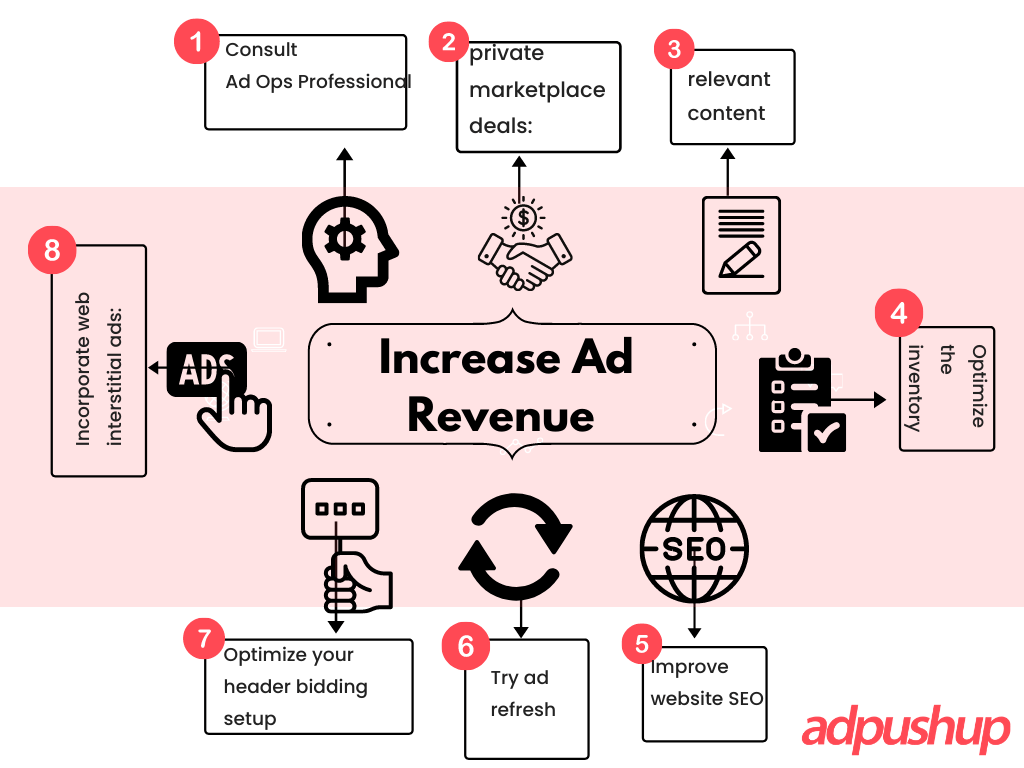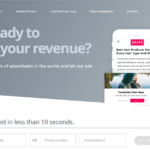6 simple techniques using which anyone can increase ad revenue from their website. You learn ad revenue optimization using testing from this article.
Some publishers believe that increasing the visitor traffic is the only sure-fire way to increase ad revenue from their blogs or websites. While increased traffic generally does mean more ad revenue, the publishers are still leaving a lot of potential ad money on the table.
For those who want to make the maximum revenue with traffic being constant, I’ll talk about an exciting concept today – Ad Revenue Optimization. Optimization is an act, process, or methodology of making something as fully perfect, functional, or effective as possible.
In short, it means to squeeze that last drop of potential ad revenue from your advertising network – be it Google Adsense or any other CPC/CPC/CPA based ad network or exchange.
Let us look at some techniques which can improve/optimize/increase ad revenue of your website, without any changes to the traffic.
1. Try Different Ad Placements
Testing different ad locations for every ad unit tops the checklist list when you are trying to increase CTR (Click through rate) for your ad units. Some common practices include:
- Placing the ad above the fold
- Integrating it with your site’s content
- Placing it near your call to action
Take an example of placing an ad unit near call to action. If your website is offering file/software downloads to your users, your CTA (Call to action) is the file/software download button and placing ads near this button can help.
But make sure you do not confuse users between the actual download button and the advertisement (which a lot of websites do on purpose) to ensure a good user experience for your website.
There is always a very thin line here as it is possible to increase the ads CTR but only at the cost of user experience. Such gains are temporary and over a longer term, as users stop coming back to your site, the overall traffic declines and so does your ad revenue.
Subtle changes relating to the ad location can take you a long way. I once worked with the owner of a popular blog (~10,000 Alexa). We moved a 200×200 unit from the left column of the page to the right side.
This small change led to 72% increase in the clicks over the ad unit for next two weeks after the shift. So, create variations and keep testing.
Case Study: How AdPushup Raised RentLingo’s Page CTR by 115%
2. Experiment With Sizes
It never hurts to try different ad sizes and compare with the ones you currently use. Got a 250×250? Try comparing it with 336×280 ad unit. Using a wide skyscraper, test it against a normal skyscraper.
The rule of thumb is a larger unit increases the CTR, but I’ve seen otherwise too. A very good example would be to remove the 728×90 Leaderboard from the header (you can move it to the footer too) and replace with the 728×15 link unit offered by Adsense.
I tried this on a couple of sites which got majority of their traffic from search engines and was able to see the CTR increase by 15-20% and the overall user experience improved as well since the ads got smaller.
Although do keep in mind that CTR increase for a link unit will not always mean increase in revenue – because link units only lead the user to further targeted ads – and the monetization follows only after an subsequent ad click.
Couple the different ad sizes with different locations/placements and you have endless options. Remove your skyscraper from the side columns and replace it with a leaderboard in the footer to see what that does.
Test crazy! You would be surprised to see how such changes reflect on your ad revenues. The trick is “Continuous optimization and tweaking” to improve and optimize website ad revenue.
Read more: AdPushup Guarantees a 20% Revenue Uplift
3. Compare Ad Networks
It doesn’t take a genius to understand how important it is to use the best ad network. The reason is simple – some networks pay more while some pay less. But that’s not the only point.
The quality and relevance of advertisements are also important. You may have placed the ads in the best possible location and in the most striking size.
But, what if the ad is not relevant to what your website user actually needs and what if the ad is not designed well? (like not having a clear call to action).
Although it is quite impractical (and also not possible in many networks) for a publisher/webmaster to track the CTR of each ad creative and screen ads on this basis, but over a period of time the network quality and relevance would speak through the CTR or eCPM (effective CPM).
It’s not necessary that only a large or well-known network gives you access to more relevant and high paying advertisers. Sometimes, a smaller network made specifically your vertical (think Insurance Ad-Network) can and should do better.
So, if you test different ad networks with the ad size and position being constant for a unit, you can actually measure and see which network is performing better (in terms of total income CTR & eCPM) over time.
Case Study: How AdPushup Helped CCNA7 Grow its Ad Revenue by 534%
4. Ad Types & Ad Designs
Have you tried comparing the CTR of an image ad with a text ad? Or, are you using the default color style on your Google Adsense Text ads?
For one of the websites I worked previously, fewer users clicked on Image Ads than the text ads (text ads were aesthetically better). I even managed to increase the conversion by 43% without changing the ad size or position.
How did I do it? I made sure only text ads were shown and I created a contrasting color theme for these text ads in relation to the website’s colors. The contrasting theme really helped in highlighting the ads.
For some sites, ad units blending in with the colors of the website have also increased CTR, specially when the ads are placed within the main content.
5. CPC vs CPM
Many large publishers don’t even talk about CPC. They just want a fixed cost for impressions delivered and why not? CPM has proved to incur more returns over a period of time for large publishers.
So let’s say, if CPC gives a revenue of $x on an average, CPM ads might enable your website to earn $1.2x or maybe more (hypothetically).
But wait, what if you are able to increase your CTR using the techniques mentioned above? It could be fairly easy to get more revenue than CPM or, maybe not. But what I’m asking you do here is to test and not assume anything.
Keeping your gut out of the way is very important when it comes to testing. Let me put it in a better way, use your gut only to create testing ideas, after that, leave the judgement on the stats. Your stats should speak for you.
Your website can be better off with CPM ads or CPC can alternately help you earn more revenue. The only way to know for sure is through testing.
6. Continuous Optimization
Contrary to what people think, testing is not one time but an ongoing process. The test should never stop, especially when it comes to ad revenue optimization in order to constantly measure visitor behavior on your website and act before the trend changes.
The best tools to see how your viewers are interacting with your site are heat-maps, scroll-maps and click-maps.
Your site, no matter how good the design is, will develop blind spots, sooner or later. It is always nice to keep an eye on these blind spots and make sure your ads do not develop one, around them.
One common thing which I’ve noticed with many popular websites (especially blogs and forums) is that returning visitors tend to ignore the advertisement on your website, and more so on every consecutive visit.
Well, then a good way to keep your CTR high should be to constantly change ad positions on your website. This is also a reason why many websites see Ad CTR sky-rocketing, right after a design change.
Although, making such changes very frequently has its own issues and takes its toll on user experience, but a webmaster can easily strike a balance here. I personally feel that once in 4-6 months should be fine enough to keep the users happy and ensure CTRs remain good too.
I’m sure the above mentioned techniques will help you increase ad revenue for your website! Keep testing and feel free to share your case studies or experiences.
Check out this infographic for more tips on increasing ad revenue:

AdPushup
Managed Demand. Adblock Recovery. Greater Revenue.
AdPushup is a full-stack ad revenue optimization platform for publishers. The features include ad layout optimization, header bidding implementation, automated A/B testing, and AdBlock recovery.
The ad ops team at AdPushup takes care of all the heavy lifting of tasks related to operations and inventory management. Additionally, they have demand-partnership with top-tier ad networks and exchanges such as Google AdX, AppNexus, Rubicon, and OpenX, among others.
AdPushup is a Google Certified Publishing Partner and trusted by 300+ publishers, including CNET, Deccan Chronicle, NDTV, and more.On average, AdPushup offers a 40% revenue uplift for their publishing partners.
Get on a call with AdPushup to understand the potential of your inventory.
FAQs
Ad revenue is the income you can earn from advertisements displayed on your content. Websites, videos, and social media platforms may display these ads on their pages.
CPC offers a higher return on investment than CPM. When you only pay for clicks, you’re only spending money on consumers. CPM campaigns result in less revenue from ad views without engagement. Marketing insights from CPC are less useful for analyzing your ads’ effectiveness.
Using data to test ad layouts, ad types and create the best user experience and drive your CTR, ad revenue optimization is the process of creating and serving ads which are relevant to users.
Ankit is a co-founder @ AdPushup (a tool which helps online publishers optimize ad revenues) and loves online marketing & growth hacking.







